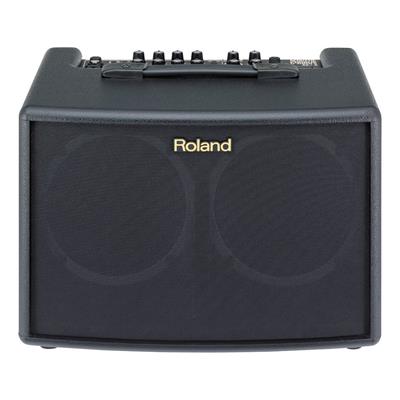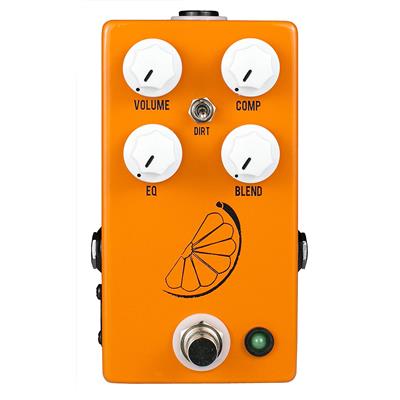| Build Quality: |  |
| Hardware: |  |
| Electronics: |  |
| Sound: |  |
| Value: |  |
| Average: |  |

Pros:
- Wide range of useful features
- Excellent on-board effects
- In-built anti-feedback system
- Great sound quality
Cons:
- Does not have an effects loop
- Might develop a certain hiss in some settings
Music world is a bit snobbish when it comes to certain devices. Smaller amplifiers are often looked down on, as they are not considered good enough for professional utilization. However, as the technology develops, brands have more and more options to incorporate all the essential features in a smaller package. The most prevalent phenomenon nowadays is that size does not actually matter. This is the case with Roland AC-60. This bad boy is quite small, but it packs an unbelievable amount of punch. This is an acoustic guitar amplifier that will change your game drastically. If you are looking for something portable, powerful and just badass, keep on reading as I discuss everything this unit has to offer in great detail.
Features
Let’s start with the basics. Roland AC-60 Acoustic Chorus is a 30 watt amplifier with stereo output, that is louder than one would expect from its power capacity. It delivers its sound through dual specially developed 6.5” wide-range speakers. It has a two channel design, featuring both guitar and MIC/Line inputs (employs phantom power). This way you can easily use two guitars simultaneously or incorporate vocals in your performance. Roland AC-60 works perfectly with both piezo and magnetic pick-ups and can even be utilized with both at the same time. What is more, this amplifier has several built-in effects, specifically designed for acoustic instruments. It features three types of Chorus (Space, Rich and Wide), stereo Reverb and Delay. Each of them can be activated using a foot controller. AC-60 has an Anti-feedback system which detects the feedback point either with “Manual Settings” or “Automatic Settings”. This bad boy also has a Mute function, which allows you to plug in both channels noiselessly or use tuner output for silent tuning. Additionally, it includes a “folding stand” and a “speaker stand adapter” which allows you to use the unit even more conveniently. Last but not least, there are multiple inputs and output connectors. AC-60 has two inputs for your instrument and microphone (the second one is a combination of XLR and TRS), a single input for your headphones, Line Out jack for connecting a mixer, recording console or any other device (includes XLR connectors and ¼” phone jacks), a Sub Woofer output for creating a punchier low end, Aux inputs for external audio sources, DI Out/Tuner Out output, and two inputs for the footswitch.
Controls
At first glance, the control panel is a bit overwhelming. You notice all these knobs and your heart starts beating faster from anxiety. However, once you start reading up and researching the functionalities of each one, you understand that everything is as simple as it can get.
There are two rows of encoders. The upper one is responsible for the guitar channel, while the other one takes care of the Line/Mic channel. They both have their own EQs, Volume knobs and Chorus buttons. I will discuss everything in depth in a minute. But before that, there are several useful switches here. The Pickup button allows you to choose a specific mode depending on which pick-ups you use – magnetic or piezo. The Shape button accentuates the midrange and makes it brighter, thus emphasizing your strumming and brushing sounds. The Phantom Power switch eliminates the chance of misconnection between the amp and external devices. It enables you to connect the microphones that require such power so that everything operates as one single body. The Select button switches the input level to match the device connected to the amplifier (between line and mic).
Let’s move on to the individual and similar controls for the channels. The Volume knob sets the level of the channel; Bass, Middle and Treble act as equalizers and allow you to shape your tone to perfection; the Chorus button turns this effect on and off. Next we have the Chorus knob, which allows you to choose between different types of the said effect and, thus, intensify them to the desirable extent, while the Reverb/Delay knob lets you pick out either of these two effects. Next we have the Anti-feedback encoder allowing you to set the frequencies at which the anti-feedback function will be activated. Start button activates the automatic feedback detection. And finally, we have the Mute button and Master volume. The former mutes the signal and enables you to plug in your instruments silently, while the latter adjusts the overall output of the amplifier.
Roland AC60 Sound
And we have moved on to the most important denominator of all – the sound. Roland AC-60 can produce a hell of a powerful tone with just simple adjustments. It pays a lot of attention to details, enabling you to create something well-optimized. The pick-up selector makes a huge difference since it discerns the exact characteristics of the incoming signal and responds accordingly. This amp has enough headroom to get loud without getting buzzy or noisy and can even drive the PA system. Roland AC-60 displays the acoustic sound in the best way possible. The best part about it is the effects that were specifically designed to meet the nature of the instrument. Space Chorus takes the signal from the left speaker and mixes it with the one from the left speaker and creates a spatial dimension that is as organic as it can get. Rich Chorus adds the effect to three different frequency ranges, making your sound fuller and broader, while the Wide Chorus expands even further and surrounds the listener from within. The Delay and Reverb are also quite distinctive and are perfect for the sounds of an acoustic guitar. On the whole, Roland AC-60 is extremely responsive and everything it emits is saturated with fullness and thickness.
Conclusion
Is there a need to underline the final verdict? I do not think so. Everything is already as clear as day. Roland AC-60 is simply an amazing amplifier that has an extensive set of features, mind-blowing sound and easy-to-grasp controls. What else do you need?
Click here to view more from 10 Best Small Guitar Amps.






Great amp 👍
Roland quality